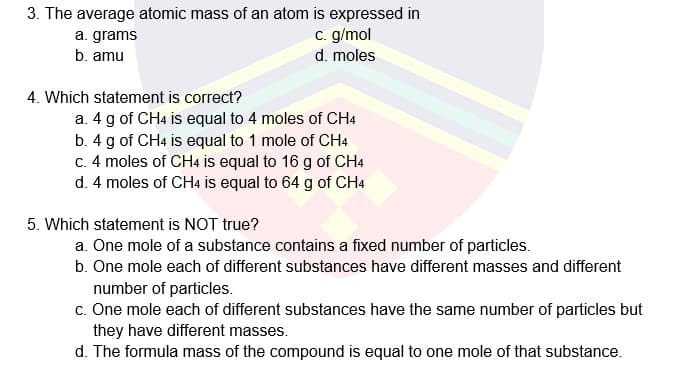3. The average atomic mass of an atom is expressed in c. g/mol d. moles a. grams b. amu 4. Which statement is correct? a. 4 g of CH4 is equal to 4 moles of CH4 b. 4 g of CH4 is equal to 1 mole of CH4 c. 4 moles of CH4 is equal to 16 g of CH4 d. 4 moles of CH4 is equal to 64 g of CH4 5. Which statement is NOT true? a. One mole of a substance contains a fixed number of particles. b. One mole each of different substances have different masses and different number of particles. c. One mole each of different substances have the same number of particles but they have different masses. d. The formula mass of the compound is equal to one mole of that substance.
3. The average atomic mass of an atom is expressed in c. g/mol d. moles a. grams b. amu 4. Which statement is correct? a. 4 g of CH4 is equal to 4 moles of CH4 b. 4 g of CH4 is equal to 1 mole of CH4 c. 4 moles of CH4 is equal to 16 g of CH4 d. 4 moles of CH4 is equal to 64 g of CH4 5. Which statement is NOT true? a. One mole of a substance contains a fixed number of particles. b. One mole each of different substances have different masses and different number of particles. c. One mole each of different substances have the same number of particles but they have different masses. d. The formula mass of the compound is equal to one mole of that substance.
Chemical Principles in the Laboratory
11th Edition
ISBN:9781305264434
Author:Emil Slowinski, Wayne C. Wolsey, Robert Rossi
Publisher:Emil Slowinski, Wayne C. Wolsey, Robert Rossi
Chapter33: Preparation Of Copper(i) Chloride
Section: Chapter Questions
Problem 5ASA
Related questions
Question

Transcribed Image Text:3. The average atomic mass of an atom is expressed in
a. grams
c. g/mol
b. amu
d. moles
4. Which statement is correct?
a. 4 g of CH4 is equal to 4 moles of CH4
b. 4 g of CH4 is equal to 1 mole of CH4
C. 4 moles of CH4 is equal to 16 g of CH4
d. 4 moles of CH4 is equal to 64 g of CH4
5. Which statement is NOT true?
a. One mole of a substance contains a fixed number of particles.
b. One mole each of different substances have different masses and different
number of particles.
c. One mole each of different substances have the same number of particles but
they have different masses.
d. The formula mass of the compound is equal to one mole of that substance.
Expert Solution
This question has been solved!
Explore an expertly crafted, step-by-step solution for a thorough understanding of key concepts.
Step by step
Solved in 2 steps

Recommended textbooks for you

Chemical Principles in the Laboratory
Chemistry
ISBN:
9781305264434
Author:
Emil Slowinski, Wayne C. Wolsey, Robert Rossi
Publisher:
Brooks Cole

Introductory Chemistry: A Foundation
Chemistry
ISBN:
9781285199030
Author:
Steven S. Zumdahl, Donald J. DeCoste
Publisher:
Cengage Learning

Introductory Chemistry: A Foundation
Chemistry
ISBN:
9781337399425
Author:
Steven S. Zumdahl, Donald J. DeCoste
Publisher:
Cengage Learning

Chemical Principles in the Laboratory
Chemistry
ISBN:
9781305264434
Author:
Emil Slowinski, Wayne C. Wolsey, Robert Rossi
Publisher:
Brooks Cole

Introductory Chemistry: A Foundation
Chemistry
ISBN:
9781285199030
Author:
Steven S. Zumdahl, Donald J. DeCoste
Publisher:
Cengage Learning

Introductory Chemistry: A Foundation
Chemistry
ISBN:
9781337399425
Author:
Steven S. Zumdahl, Donald J. DeCoste
Publisher:
Cengage Learning

Chemistry: Principles and Reactions
Chemistry
ISBN:
9781305079373
Author:
William L. Masterton, Cecile N. Hurley
Publisher:
Cengage Learning

Chemistry: Matter and Change
Chemistry
ISBN:
9780078746376
Author:
Dinah Zike, Laurel Dingrando, Nicholas Hainen, Cheryl Wistrom
Publisher:
Glencoe/McGraw-Hill School Pub Co

Principles of Modern Chemistry
Chemistry
ISBN:
9781305079113
Author:
David W. Oxtoby, H. Pat Gillis, Laurie J. Butler
Publisher:
Cengage Learning